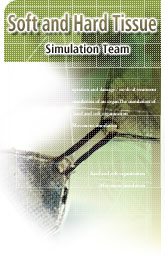 
|
|
|
 |
 |
 |



Our team has developed a dynamic simulator that is used for human tissues in order to simulate injuries and treatment of human organs, analyze the developmental mechanisms of human diseases, and preoperatively simulate surgical operations. In addition, although it is quasi-static, the dynamic simulator described in this report is not used for real-time simulation during operation but for a simulation that accurately reproduces the dynamic reactions that occur in tissues. The three problems that are generally associated with the dynamic analysis of biological tissues are as follows.


 |
It is very difficult to configure biological shape and mechanical characteristics. In industrial fields where fine element analysis is mainly applied, the shape and mechanical characteristics of an analytical object are defined by a design drawing. However, there is no such drawing for the human body. Therefore, in order to simulate human organs, a design drawing must first be created for the human body. |
 |
 |
 |
 |
Deformations of the human body are nonlinear and large, and they exhibit. In order to solve this problem, the development of a dynamic model and an FEM program based on this model is necessary in order to express the deformation behavior of biological tissues. |
 |
 |
 |
 |
It is very difficult to reconstruct a tissue that is physiologically reactive against a dynamic stimulus. In order to solve this problem, a dynamic simulation model must be constructed by also considering tissue reconstruction. |


It is very difficult to develop a simulator for all organs that also takes into account all these three problems. Therefore, the following simulations were separately developed: (1) simulation of soft tissues and (2) simulation of hard tissues such as bone.
In the simulation of soft tissues, we considered abovementioned problems 1 and 2, and thus, we aimed to develop a preoperative simulator for the retinal detachment operation of an eyeball.
In the simulation the hard tissues, we considered abovementioned problems 1 and 3, and thus, we aimed to develop a simulator to reproduce bone remodeling.

 

 |
 |
 |
 |
| (1) |
Soft Tissue Simulation |
 |
 |
| (2) |
Hard Tissue Simulation |
 |
|
 |
 |
 |
 |
|
|
|
|
|

